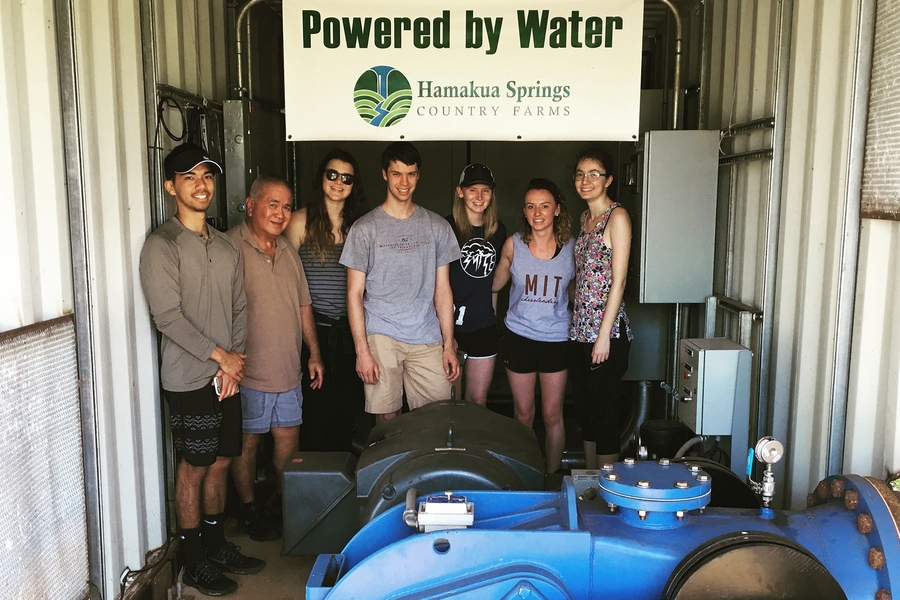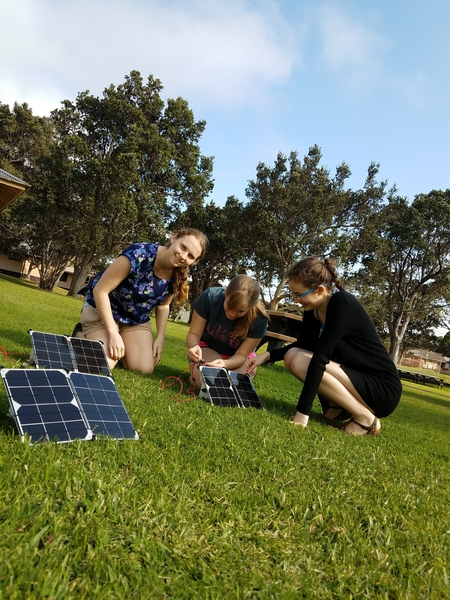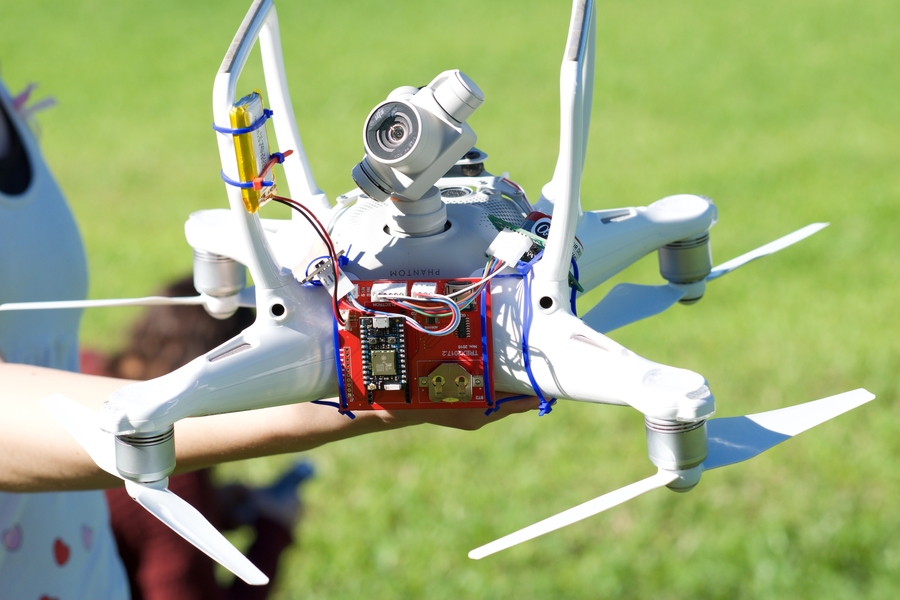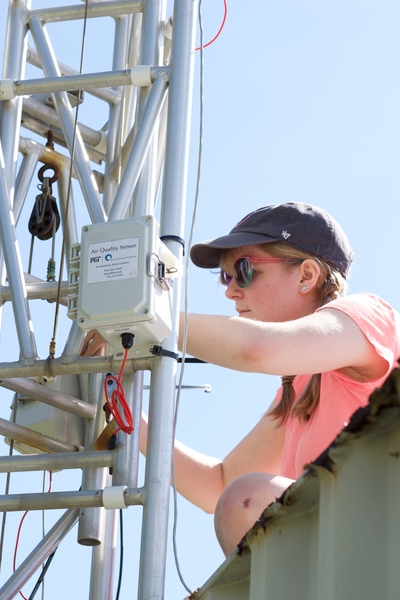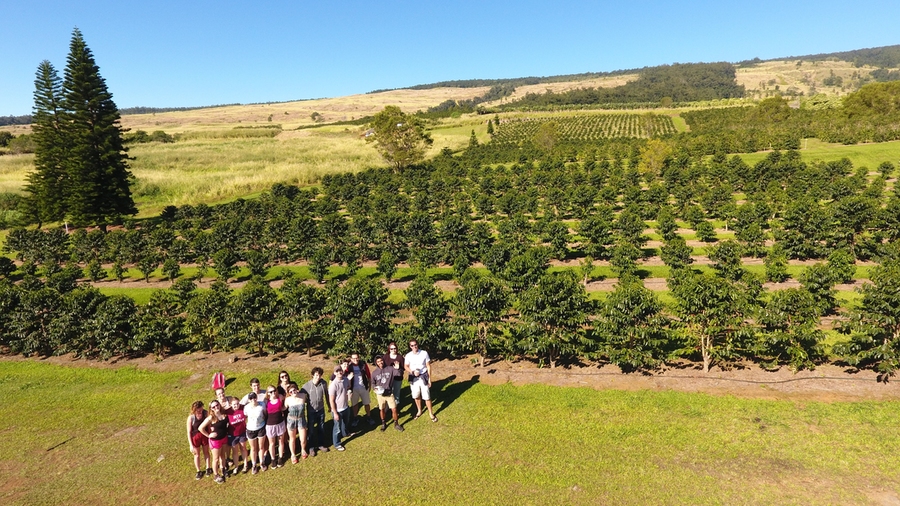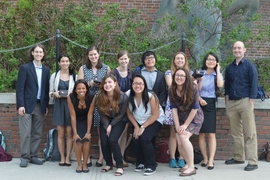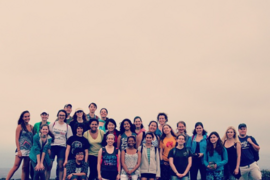In MIT's Department of Civil and Environmental Engineering (CEE), students are encouraged to apply material from class and to get hands-on experience in the field. From monitoring air quality and conducting chemical analysis of soil samples, to learning about Hawaiian culture, a group of undergraduate students gained this real-world experience through a unique program that takes them to the Island of Hawaii ("the Big Island") over the month-long Independent Activities Period (IAP) in January.
Traveling Research Environmental eXperiences (TREX) is a fieldwork experience that takes a group of undergraduates from CEE and other departments, along with CEE professors and teaching assistants, to the Big Island to monitor air quality and to study plant health. The two-week adventure involves creating air sensors, installing them in various locations on the island, and coupling chemical analysis with images from drones to monitor plant health from multiple locations. The research is supplemented with adventures such as visiting live volcanoes, seeing a lava pond and going to the beach.
“Field subjects like TREX are an integral part of the CEE undergraduate curriculum, as they offer deep exposure to a real-world setting in which theory and practice meet. TREX supports our department’s focus on the environment and infrastructure; the research experience demonstrates how the world is our classroom,” said CEE department head and McAfee Professor of Engineering Markus Buehler.
Professors prepare students for fieldwork
TREX has been taking students out of the classroom and into the field since 2000. They have studied in international and domestic settings, but this year was the 12th year the trip has returned to Hawaii.
This year's TREX was led by assistant professor of civil and environmental engineering Ben Kocar, associate professor of civil and environmental engineering and chemical engineering Jesse Kroll, and associate department head and Mitsui Career Development Associate Professor Colette Heald. The professors were supported by two teaching assistants, David Hagan and Jon Kaneshiro, both graduate students in CEE.
TREX revolves around two research projects that evolve and build off of each other year after year. Kroll leads one project, started in 2015, that measures sulfur dioxide by building and installing low-cost portable sensors in public spaces around the Big Island. Kocar leads the other project that looks at soil nutrients and plant health by collecting soil and plant tissue and supplementing those samples with images from an unpiloted aerial vehicle (UAV).
A week before the group departed for Hawaii, everyone met daily to learn about the two projects and to research and present on the geography, history and demographics of the Big Island. The group received a tutorial from CEE postdoc Will Porter on the programming language R, which was essential for analyzing the data collected. The students are encouraged to take the lead on these projects, so they participated in paper discussions to understand UAV and remote-sensing techniques that they would need in the field. But it isn’t easy to create a method for an environment that the students haven’t seen. “They started the methodology almost on the fly, which is part of what we want. We want to immerse them and then say, ‘alright, this is your project,’” Kocar said.
"Fieldwork requires resourcefulness"
From January 13 to 27, the group adjusted to Hawaii and was able to both create and execute methods for their projects. From gathering soil samples to installing portable sensors on school houses with zip-ties, the students got a taste of the nature of fieldwork. Although met with some setbacks — such as accidentally mixing soil samples and waiting too long for reactions to occur during chemical analysis — students came away from the trip with a deeper understanding of a fieldwork experience.
“One thing I learned from TREX is that fieldwork is not perfect. Sometimes things don’t work, or you don’t have something that you need because you aren’t in a lab. Fieldwork requires resourcefulness and a lot of critical thinking to get the work done with the materials at hand,” said Alexa Jaeger, a third-year student in CEE and the Department of Earth, Atmospheric and Planetary Sciences.
On the first few days of the trip, the students presented their research and findings to MIT alumni. Despite being only a few days into their research, the group was able to present what they were studying and details of the projects, Kocar recalls. “MIT alumni know what MIT students’ strengths and weaknesses are, and they’re able to ask questions relating to both of those things. The alumni ask them thought-provoking and intelligent questions, but are supportive at the same time,” Kocar said.
The TREX students got a glimpse of not only the research environment in Hawai‘i, but also got to interact with local residents. Richard Ha, the owner of a local farm where one group collected data on a sweet potato farm, gave a tour of his land and showed how he creates his own electricity. They also toured the Hawaii Volcano Observatory, observed a lava pond, and hiked to see Hawaii Volcanoes National Park.
Every year, TREX culminates with a presentation to the community that highlights the key findings of their research. This year, the group presented their measurements and findings at the Natural Energy Laboratory of Hawaii Authority Gateway Energy Center. The students presented their findings to an audience of community members, including David Fuertes, one of the farmers who let the students study his land, and a few retired scientists.
The projects produced impressive results. Since Kroll and his students started the low-cost air quality sensor project in 2015, the sensors have improved. Now, they are able to collect data that mirrors data from the Hawaii Department of Health, but at a much lower cost. The students also saw in their SO2 sensor data that there is potential to get much more detailed spatial information, by monitoring SO2 with the UAV. Kocar’s project, which examines soil and plant health on various farms, demonstrated wide variability in soil properties essential for supporting crops, even within a seemingly small 7-acre field. These properties include soil moisture, nutrient content, and other chemical parameters such as pH; the soil samples they collected will be further analyzed for additional nutrients in the spring semester.
Continuing research at MIT
TREX may only be few weeks long, but the students continue their research during 1.092 (Traveling Research Environmental eXperience: Fieldwork Analysis and Communication), a spring subject that follows the trip. The students researching air quality with Kroll will “examine the calibration of the sensors and learn how to convert signal (voltage) to SO2 concentration, and how this calibration may change over weeks to months. They will also try to use the SO2 data to understand what controls the distribution of SO2 across the island, and to what extent people in different areas/communities are exposed to it,” Kroll said.
Kocar’s group will seek to improve their image processing capabilities, which will aid their interpretation of UAV remote sensing data. They will also analyze the soil samples they collected and link these measurements with UAV data, with the goal of deciphering soil properties that may be limiting crop growth in different areas of a field. “Important plant nutrients that are applied are nitrogen, phosphorous, and potassium. We’ll be analyzing the soil and plant tissue samples for those nutrients and also how plant-available they are in the soil in different locations throughout the field area,” Kocar said.
TREX research doesn’t end at the end of the semester, either. Sometimes, going on TREX results in students getting published in academic journals. In 2015, research collected from Kroll’s project on TREX was published in Environmental Science and Technology for a paper on “Atmospheric Evolution of Sulfur Emissions from Kilauea.”
“There are two reasons that TREX is really amazing. Scientifically, the students get to really dig in to fieldwork in a short amount of time. Every year the students collect so much data and do so much analysis in two weeks, and 99 percent of them love it; they love to dig in full force and get these amazing results,” Kocar said. “They’re also doing fieldwork in an amazing place. From the sweet potato farm that we were on, you could see Mauna Kea on one side and the ocean on the other. The diversity of the plant life, the culture of Hawaii is just incredible to soak in.”
